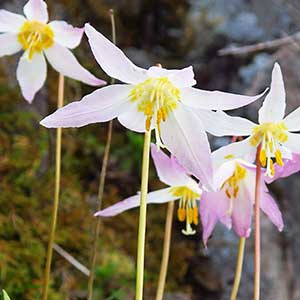Erythronium elegans
Erythronium multiscapideum
Coast Range fawn lily, elegant fawn-lily
Sierra fawn-lily, Sierra foothills fawn-lily
slender, 30–50 mm.
ovoid, 20–50 mm, producing bulbels (usually 1–3 per parent bulb) at ends of long, slender stolons.
7–20 cm;
blade green or faintly mottled with brown or white, narrowly ovate, margins often wavy.
4–16 cm;
blade mottled with irregular streaks of brown or white, ± lanceolate, margins entire to wavy.
10–30 cm.
8–23 cm, branching just above leaves near ground level when flowers more than 1.
1–2(–4)-flowered.
1–4-flowered.
tepals: inner ± white, outer ± white and tinged (often strongly) with pink, especially abaxially and along midline, becoming more generally pinkish with age, both inner and outer with yellow band at base, lanceolate to narrowly elliptic, 20–40 mm, abaxial surfaces and outer tepals often darker, inner auriculate at base;
stamens 13–22 mm;
filaments white, flattened, slightly widened, linear to lanceolate, 0.8–2 mm wide;
anthers yellow;
style white, 10–20 mm;
stigma with slender, usually recurved lobes 2–4 mm.
flowering individuals generally uncommon in populations, most plants 1-leaved and vegetative;
tepals white to cream with yellow base, broadly lanceolate to elliptic, 16–40 mm, inner with small auricles at base;
stamens 10–15 mm;
filaments white, linear, slender, less than 0.8 mm wide;
anthers white to cream;
style white, 10–13 mm;
stigma unlobed or with recurved lobes 1–4 mm.
obovoid to oblong, 2–5 cm.
obovoid, 2–5 cm.
= 48.
= 24.
Erythronium elegans
Erythronium multiscapideum
Of conservation concern.
This species is endemic to the Coast Ranges of western Oregon.
(Discussion copyrighted by Flora of North America; reprinted with permission.)
Erythronium multiscapideum is unusual among western species (and resembles some eastern species) in its tendency to reproduce vegetatively through the production of bulbels at the ends of stolons. It is similar in many respects to E. californicum and sometimes intergrades with it, resulting in occasional populations with the bulb characteristics of one species and the inflorescence branching pattern of the other.
(Discussion copyrighted by Flora of North America; reprinted with permission.)
- Local floras:
CA,
OR
- Local Web sites:
CalFlora,
CalPhotos,
Flora NW,
PNW Herbaria
WildflowerSearch
iNaturalist (observations)
- LBJ Wildflower Center
- SEINet
- Plants of the World Online
- Encyclopedia of Life
- Wikipedia
- Google Image Search


